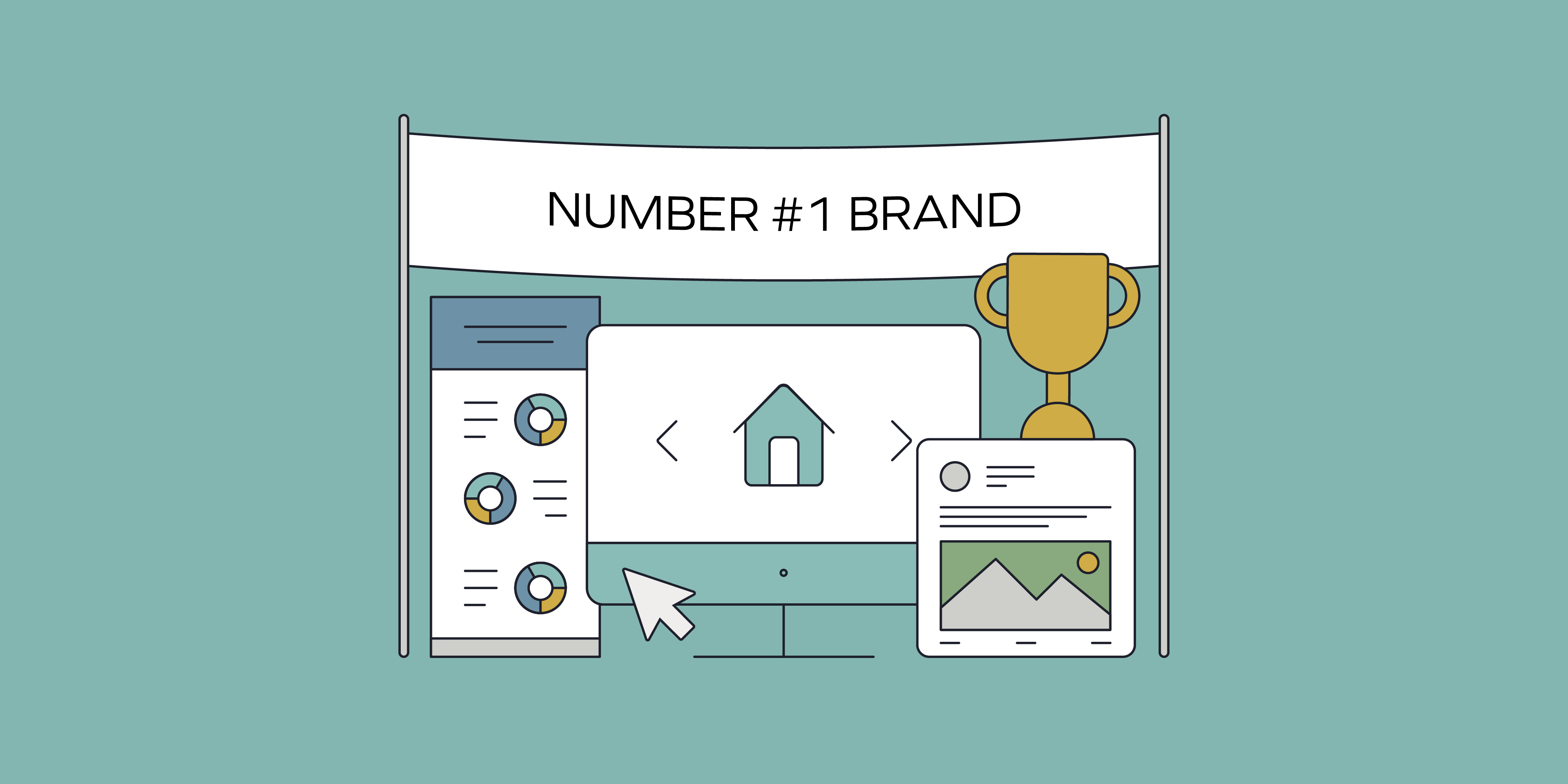The ROI of brand building: Why investing in your brand pays off
22nd April 2025 •
22nd April 2025 •

These days, it can feel like brand building gets a raw deal. Out there in the crowded B2B landscape, performance marketing can often steal the spotlight, upstaging brand-building activities when these are often the real key to long-term growth.
The trouble is, while performance campaigns are great for driving immediate results, it’s brand that underpins lasting commercial growth. Too many people spend untold resources on complex programs desperately trying to find the 5% of people who are in-market at any given moment, and convert them. That’s not a growth strategy, it’s an optimisation strategy.
That’s not to say performance marketing isn’t important – its role within a broad customer acquisition strategy is clear – but it’s your brand that plays into the human psychology behind how B2B buyers make decisions, targeting 100% of your audience to become a familiar and memorable brand. Planting a seed in the potential buyer’s mind that will grow to make your business the go-to choice once they’re ready to purchase. Generally, people think of up to three brands when beginning a strategic B2B purchasing journey, and the data shows that the majority of the time it’s one of these brands that tends to win.
So how do you move towards becoming one of the three? What ensures you are front-of-mind and on that initial shortlist? What exactly are brand-building marketing activities and why are they so important? How should you budget for them – and most crucially – how do you measure their success?
Let’s break it down…
We’re simply talking about activities primarily focused on creating a strong, memorable presence in the mind of your target audience – one that resonates emotionally as well as rationally. Such activities will not be directly tied to short-term sales. Instead, they’ll be crucial for building brand recognition, familiarity, trust, and loyalty, over time and naturally bring more people through your door over the long-term.
This means blending clear positioning and high-impact creative ideas that grab attention with go-to-market strategies that amplify their reach, sustain engagement, and leave a lasting impression. While digital media remains central to brand-building campaigns, traditional channels such as out-of-home, sponsorships, events, print, and even TV extend visibility and deliver significant impact, remaining highly relevant even in B2B contexts.
In any B2B market, building equity into your brand is essential for long-term growth. Brand-building campaigns enhance:
Together, these enhancements can move your business from being just another option, to the brand that’s top-of-mind and the default choice. Even in a highly competitive market, the stronger your brand presence, the more likely prospects are, psychologically, to favour your offering first. It’s about affecting the way audiences subconsciously feel about you, as well as what they think about you.
There’s always a need to balance strategy, creative and media spend. Obviously, budgets differ from business to business. Much will depend on your growth targets, revenues, and general appetite for investing in marketing. Plus, you don’t have to be a marketing genius to know that generally, the more you spend relative to your competition, the greater your brand impact and share of voice in the market (the two critical components that underpin growth).
However, when it comes to brand building, there is a basic formula for finding the right budget balance between creative development and media spend.
The best practice ratio for brand building campaigns:
And here’s why this ratio works:
In contrast, short-term performance marketing campaigns usually lean towards 80% – 90% media spend, as the goal is less about creative impact and more about identifying businesses that are already in-market, and converting them efficiently. However, this is an optimisation strategy, not a growth strategy – one of the biggest misconceptions in B2B marketing. Importantly, demand generation and performance marketing activity will always be most effective when there is existing, strong brand familiarity and credibility to build upon.
Measuring the return on marketing investment from brand-building activities is notoriously challenging. That’s because the effects are felt over the long-term and less instantly than lower-funnel tactics. Unlike performance marketing, where conversions and revenue are directly trackable, brand-building impacts are often perceptual, gradual, and compounding. And while brand campaigns undoubtedly enhance the effectiveness of performance tactics, this impact is often mistakenly credited to lower-funnel communication optimisations.
However, below are some of the methods and metrics you should employ to measure success, and gauge whether you’re making an impression or not.
While it’s possible to directly link some leads and sales conversions to brand-building campaigns using traditional analytics, the real power of brand-driven growth shines when you visualise the results. Try plotting commercial trend data on graphs and overlaying the initiation of brand activity—you’ll be amazed at what you see!
In the world of B2B, the decision-making process can be longer and more complex than in B2C. So your brand-building campaign should aim for a positive, long-term ROMI with a model that combines brand awareness, brand engagement, and brand demand metrics. Trend data is core to this and best way to prove ROI. The reality is, building brand relationships and nurturing prospects takes time.
The good news, however, is that commitment to a long-term investment in brand building has a compounding effect. In other words, by establishing a strong and consistent brand presence, you increase the efficiency and effectiveness of any future media spend, ultimately leading to higher levels of in-market impact. In short, as brand equity rises, the cost of acquiring new customers reduces, and existing customers become more loyal, further improving ROMI over time.
Building brands is like planting seeds: you’ll see nothing overnight, but careful watering and nurturing will result in strong, sustained growth. Likewise, the more you invest in creating awareness and positive associations now, the stronger and more enduring your brand will become. Over time, this will bloom into:
Investing in brand building has been proven to significantly enhance ROMI over time – and there are many notable studies supporting this. Here’s some further reading that could help:
Boston Consulting Group (BCG) and Google’s Joint Survey: this found that companies with advanced brand marketing capabilities experienced a ROMI increase of approximately 46% compared to less mature counterparts. BCG Global
Kantar and WARC’s Research on Creative Quality: a report that showed high-quality, creative ads can generate over four times more profit than less creative ads, underscoring the financial benefits of investing in strong brand-building initiatives. Kantar
The Multiplier Effect Report: according to this, integrating brand and performance marketing can boost ROI by 25% to 100%, with an average increase of 90%. The report recommends allocating 40-60% of marketing budgets to brand marketing to achieve this balance. The Australian
Collectively, these studies (which are just a small selection) deliver a powerful demonstration of the way a strategic investment in brand building could not only enhance you market presence, but also lead to measurable financial benefits.
If you’re serious about brand-driven growth (like we are), then as important as immediate results are, don’t forget about laying the foundation for sustained long-term growth.
By investing wisely in positioning, creative and media, and measuring success through a combination of short-term engagement and long-term brand equity, there’s every chance that your brand will be front-of-mind when those strategic B2B purchasing journeys begin.
Your goal isn’t simply to be seen – it’s to be remembered. In a world saturated with competing messages, making your brand unforgettable is the ultimate path to long-term success.

At Torpedo, we specialise in helping B2B brands create meaningful impact – not just impressions. Whether you’re starting from scratch or evolving an existing identity, our team is here to help you define, build and activate a brand that drives real results.
Get in touch